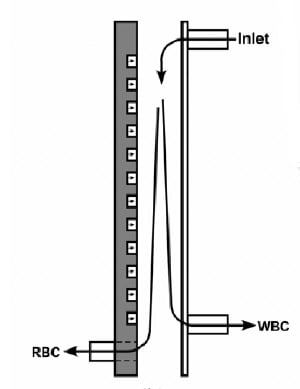A physicist in the US has proposed a new way to separate red and white blood cells using a magnetic field. The method, which has not yet been proven in the laboratory, exploits the fact that white and deoxygenated red blood cells move in different directions when they are close to a magnet. According to Edward Furlani of the University of Buffalo, the technique offers several important advantages over existing separation methods, and if realized, could be used in a variety of medical applications (J. Phys. D: Appl. Phys. to be published).

Whole blood contains red and white blood cells that are suspended in watery fluid called plasma. These constituents are separated out from donated blood because a patient may only need one component at any one time. Separation also plays an important role in the analysis of blood cells for the diagnosis and treatment of diseases.
The most common way to separate the components is by spinning blood samples at high speeds in a centrifuge. However, it can take about 20 minutes to process a test-tube sized sample, which is a problem if the components are needed immediately. This new method could take just a few minutes to separate an equivalent quantity of blood, claims Furlani.
Furlani’s design proposal involves placing an array of soft magnets next to a microfluidic channel (see figure “Magnetophoretic microsystem”). A sample of deoxygenated blood would be placed inside the channel and a external magnetic field applied to the system. The cells are separated by magnetophoresis, a technique that uses magnetic fields to move particles according to their magnetic properties.
According to Furlani’s calculations, the red blood cells will move in one direction inside the channel and the white blood cells in the opposite direction. This occurs because red blood cells are paramagnetic and therefore are attracted to the array of magnets, while white blood cells are diamagnetic and therefore repelled away from the magnets. However, the technique will only work if the red cells are deoxygenated (contain no oxygen), because ordinary, oxygenated red cells are diamagnetic.
According to Furlani, his technique could be used to create a portable, low-power and easy-to-manufacture device capable of processing small volumes of blood in emergency situations. Furlani intends to build a prototype device to test his design.



